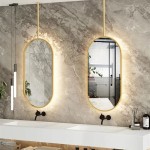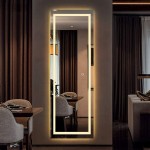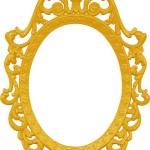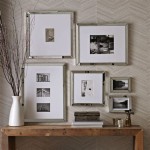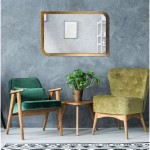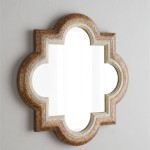Vintage Floor Mirrors: Timeless Elegance and Functional Art
Vintage floor mirrors are more than just reflective surfaces; they are historical artifacts that bring character, sophistication, and a sense of timeless elegance to any living space. These mirrors, crafted in various styles and periods, offer a glimpse into past eras while serving practical purposes within modern homes. This article explores the allure of vintage floor mirrors, examining their historical significance, stylistic variations, selection considerations, and maintenance requirements, helping readers appreciate the unique value they bring to interior design.
The Historical Significance of Floor Mirrors
Floor mirrors, in their earliest forms, were symbols of luxury and status. Prior to the widespread availability of affordable glass manufacturing, large-scale mirrors were accessible only to the wealthy aristocracy. The construction of these mirrors involved intricate and painstaking techniques, often relying on skilled artisans who specialized in glassblowing, silvering, and frame making. Initially, mirrors were made using polished metal surfaces like silver or bronze, which, while reflective, were not as clear or durable as later glass versions.
The development of glass manufacturing in Europe, particularly in Venice during the Renaissance, revolutionized mirror production. Venetian artisans perfected techniques for creating exceptionally clear and large sheets of glass, making Venice the epicenter of mirror production for centuries. These mirrors were hand-silvered using a mercury amalgam, a process that, while providing a highly reflective surface, was also extremely dangerous for the artisans involved. The mirrors were often framed in elaborate designs, reflecting the artistic styles of the period – Baroque, Rococo, and Neoclassical – using materials like gilded wood, precious metals, and intricate carvings.
As mirror production techniques advanced, and manufacturing spread beyond Venice, floor mirrors became more accessible to a wider segment of society. The 18th and 19th centuries saw the emergence of various styles of floor mirrors, reflecting the prevailing aesthetic trends of the time. The rise of industrialization further impacted mirror production, allowing for mass production and lower costs, making these once-exclusive objects more readily available to the middle class. Despite their increased availability, floor mirrors continued to be seen as valuable additions to the home, enhancing both aesthetics and functionality.
Today, vintage floor mirrors are highly sought after by collectors and interior design enthusiasts alike. They represent a tangible connection to the past, embodying the artistry and craftsmanship of bygone eras. These mirrors often possess unique characteristics, such as aged glass, patinated frames, and subtle imperfections, which contribute to their charm and authenticity. Owning a vintage floor mirror is akin to owning a piece of history, adding depth and character to any space.
Stylistic Variations in Vintage Floor Mirrors
Vintage floor mirrors come in a wide array of styles, reflecting the diverse artistic and design movements throughout history. Understanding these stylistic variations is crucial for selecting a mirror that complements the overall aesthetic of a room.
Victorian Floor Mirrors: Known for their ornate detailing and opulent designs, Victorian floor mirrors often feature intricate carvings, gilded accents, and heavy frames. These mirrors reflect the Victorian era's emphasis on embellishment and grandeur. Common materials include dark woods like mahogany and walnut, often adorned with floral motifs, scrollwork, and elaborate crests. Many Victorian floor mirrors are full-length and designed to stand alone, adding a touch of drama and sophistication to bedrooms or dressing rooms.
Art Deco Floor Mirrors: Characterized by geometric shapes, bold lines, and luxurious materials, Art Deco floor mirrors embody the elegance and modernity of the 1920s and 1930s. These mirrors frequently incorporate materials such as chrome, glass, and exotic woods like ebony or rosewood. The designs often feature stepped patterns, sunburst motifs, and stylized representations of natural elements. Art Deco floor mirrors typically have a sleek and streamlined appearance, making them suitable for contemporary or minimalist interiors.
Mid-Century Modern Floor Mirrors: Emphasizing simplicity, functionality, and clean lines, Mid-Century Modern floor mirrors reflect the design philosophy of the post-World War II era. These mirrors often feature minimalist frames made from materials like teak, walnut, or metal. The designs tend to be understated and functional, focusing on the mirror's reflective qualities rather than elaborate ornamentation. Many Mid-Century Modern floor mirrors are designed to lean against a wall or stand on simple legs, offering a blend of practicality and stylishness.
French Provincial Floor Mirrors: Inspired by the rustic charm of the French countryside, French Provincial floor mirrors feature soft curves, distressed finishes, and delicate detailing. These mirrors often incorporate materials like painted wood, wrought iron, and linen. The designs commonly include floral patterns, scrollwork, and muted colors like cream, pastel blue, or lavender. French Provincial floor mirrors evoke a sense of warmth and comfort, making them well-suited for bedrooms, living rooms, or entryways.
Hollywood Regency Floor Mirrors: Epitomizing glamour and extravagance, Hollywood Regency floor mirrors feature bold designs, luxurious materials, and dramatic ornamentation. These mirrors often incorporate materials such as mirrored glass, gold leaf, and velvet. The designs commonly include geometric patterns, stylized floral motifs, and opulent accents. Hollywood Regency floor mirrors add a touch of drama and sophistication to any space, reflecting the lavish lifestyle of the Golden Age of Hollywood. They are often large in scale, designed to make a statement and reflect light extensively.
Identifying the specific style of a vintage floor mirror requires careful examination of its materials, design elements, and overall aesthetic. Understanding these stylistic nuances allows one to select a mirror that complements the desired interior design scheme and enhances the overall ambiance of a space.
Considerations When Selecting a Vintage Floor Mirror
Choosing a vintage floor mirror requires careful consideration of several factors, including size, condition, authenticity, and placement. A well-informed decision ensures that the mirror not only complements the space but also withstands the test of time.
Size and Scale: The size of the floor mirror should be proportional to the dimensions of the room. A large mirror can overwhelm a small space, while a small mirror may get lost in a large room. Consider the height of the ceiling and the width of the wall where the mirror will be placed. A full-length mirror is ideal for dressing rooms or bedrooms, while a shorter mirror may be suitable for entryways or hallways. Ensure enough clearance around the mirror to avoid obstructions and allow for comfortable viewing. Consider also the weight; larger older mirrors could be surprisingly heavy.
Condition and Authenticity: Thoroughly inspect the mirror for signs of damage, such as cracks, chips, or scratches in the glass. Examine the frame for structural integrity, looking for loose joints, missing pieces, or evidence of woodworm. While some degree of wear and tear is expected in vintage items, excessive damage can compromise the mirror's appearance and functionality. Verify the authenticity of the mirror by researching its style, materials, and construction techniques. Consult with experts or appraisers if necessary, especially for high-value pieces. Be wary of reproductions or replicas that are misrepresented as original vintage items.
Placement and Purpose: The placement of the floor mirror should be strategic, maximizing its reflective qualities and enhancing the overall aesthetics of the room. Position the mirror to reflect natural light, making the space appear brighter and more spacious. Avoid placing the mirror opposite cluttered areas or unflattering views. Consider the mirror's purpose – is it primarily decorative, functional, or both? A mirror in a dressing room should provide a full-length reflection, while a mirror in a living room may serve as a focal point, reflecting artwork or architectural details. Ensure the placement does not create glare or reflections that could be distracting or uncomfortable. Always consider safety to prevent tipping, especially with free-standing models; securing it to the wall might be needed depending on its design and weight.
Material and Craftsmanship: Examine the materials used in the mirror's construction. High-quality materials indicate superior craftsmanship and longevity. Look for solid wood frames, beveled glass, and durable finishes. Antique mirrors may feature hand-silvered glass, which exhibits a distinctive patina and subtle imperfections that add to their charm. Assess the quality of the joinery, carving, and finishing details. Mirrors crafted by renowned artisans or manufacturers may command higher prices due to their historical significance and exceptional craftsmanship. The style of frame construction has a direct impact on its longevity. Avoid materials that are too brittle or show obvious signs of degradation. Examine the back of the mirror also, looking for evidence of repair or replacement of original material.
Price and Value: Research the market value of similar vintage floor mirrors to ensure that the asking price is fair and reasonable. Consider the mirror's condition, authenticity, rarity, and aesthetic appeal when assessing its value. Compare prices from different sources, such as antique dealers, auction houses, and online marketplaces. Be prepared to negotiate, particularly if the mirror has significant flaws or lacks provenance. Investing in a high-quality vintage floor mirror can be a worthwhile endeavor, as these items often appreciate in value over time, becoming treasured heirlooms passed down through generations. Remember, price is not always indicative of true value, so thorough research is essential.
By carefully considering these factors, one can select a vintage floor mirror that enhances the beauty and functionality of any space, adding a touch of history and elegance to the home.

Antique Carved French Style Floor Mirror Charmydecor

1670mm Oversized Vintage Gold Ornate Full Length Floor Mirror Baroque Decor Art Homary

Neutype 64x22 Arch Full Length Vintage Mirror Black Com

Magnificent Antique French Ballroom Mirror In Shimmering Gilt Description From Eloquenceinc Com I Searched Fo Vintage Mirrors Floor Big

22 X 64 Vintage Gold Full Length Mirror Antique Floor With Ornate Carvings Victorian Design French Baroque For Living Room Or Bedroom By Barnyard Designs Com

Extralarge Full Length Wall Floor Mirror Shabby Vintage Chic Bedroom Home Wooden

Floor Mirror In French Style Sq0936508 Osman Antique

All Solid Wood Dressing Mirror Pure Full Length Retro Floor European Style Bedroom China Made In Com

Huge Metal Dressing Mirror Antique Farmhouse

Antique French Floor Mirror At Horchow Antiques

